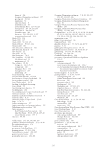123 13 Kati Thanda-Lake Eyre – not just a wildlife paradise but also an economic lifeline Trevor Wright Introduction Kati Thanda-Lake Eyre, the new name for Lake Eyre rightly reflecting its Aboriginal connection, and its rivers are increasingly on the tourist map around Australia and the world, a reflection of their magnificent cultural and environmental values. Despite this, the tourism industry and its capacity to cater for increasing numbers of visitors is not well developed in many parts of the Lake Eyre Basin (Schmiechen 2004). There is much less known about the sustainable economic values which flow when people are provided opportunities to appreciate these values through tourism. My business is tourism, focused on Lake Eyre. We have already shown that our business is growing and primarily because of the status of this river basin and the water it occasionally delivers to Lake Eyre. It is very important that the river continues to flow uninterrupted, not only for its environmental and cultural values, but also to support the sustainable businesses in the river basin such as ours, which is so dependent on tourism. People come to visit Lake Eyre because it is one of Australia’s natural wonders. Lake Eyre and its boom and bust cycles are our big draw card. I live almost a stone’s throw away from Kati Thanda-Lake Eyre. We charter aircraft from William Creek, Marree and Coober Pedy to fly over Lake Eyre (Fig. 13.1). This aerial perspective gives people a wonderful idea about the sheer size of this magnificent wetland. We also provide accommodation, fuel and supplies for tourists. The floods make a huge difference to our small communities in South Australia, substantially increasing the number of visitors to our region and their financial contribution. Tourism provides jobs. When water flows into the lake, it triggers the movement of mainly retired and semi-retired people to our remote region, often fuelled by stories in the media. The lake is increasingly important as an economic resource as tourism grows. Our Lake Eyre economy The value of Kati Thanda-Lake Eyre to our region’s economy really began during the floods of 2000, when public interest in the lake began to grow. About five years later, flows reached the lake with a small flood, which produced another spike in tourism. The floods of 2010 moved interest and numbers to an unprecedented level as it became widely known that the rivers were flowing into Lake Eyre, popularised by the magnificent ABC documentaries also captured in a book (Lockyer 2012). About 99% of our visitors are Australians, predominantly ‘baby-boomers’ keen to visit Lake Eyre once in their lifetimes. They come mostly from
Downloaded from CSIRO with access from at 216.73.216.88 on Nov 13, 2025, 8:59 AM. (c) CSIRO Publishing

















































































































































































































































































